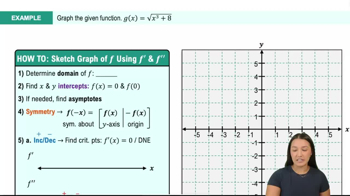Table of contents
- 0. Functions7h 52m
- Introduction to Functions16m
- Piecewise Functions10m
- Properties of Functions9m
- Common Functions1h 8m
- Transformations5m
- Combining Functions27m
- Exponent rules32m
- Exponential Functions28m
- Logarithmic Functions24m
- Properties of Logarithms34m
- Exponential & Logarithmic Equations35m
- Introduction to Trigonometric Functions38m
- Graphs of Trigonometric Functions44m
- Trigonometric Identities47m
- Inverse Trigonometric Functions48m
- 1. Limits and Continuity2h 2m
- 2. Intro to Derivatives1h 33m
- 3. Techniques of Differentiation3h 18m
- 4. Applications of Derivatives2h 38m
- 5. Graphical Applications of Derivatives6h 2m
- 6. Derivatives of Inverse, Exponential, & Logarithmic Functions2h 37m
- 7. Antiderivatives & Indefinite Integrals1h 26m
- 8. Definite Integrals3h 25m
5. Graphical Applications of Derivatives
Curve Sketching
Problem 3.6.54b
Textbook Question
{Use of Tech} Fuel economy Suppose you own a fuel-efficient hybrid automobile with a monitor on the dashboard that displays the mileage and gas consumption. The number of miles you can drive with g gallons of gas remaining in the tank on a particular stretch of highway is given by m(g) = 50g−25.8g²+12.5g³−1.6g⁴, for 0≤g≤4.
b. Graph and interpret the gas mileage m(g)/g.
 Verified step by step guidance
Verified step by step guidance1
First, identify the function for mileage given by m(g) = 50g - 25.8g² + 12.5g³ - 1.6g⁴, and understand that this function represents the total miles driven based on the gallons of gas g.
Next, to find the gas mileage, you need to compute the ratio m(g)/g, which represents the miles per gallon. This can be expressed as (50g - 25.8g² + 12.5g³ - 1.6g⁴) / g for g > 0.
Simplify the expression for m(g)/g by dividing each term in the numerator by g, resulting in the function m(g)/g = 50 - 25.8g + 12.5g² - 1.6g³.
Determine the domain of the function m(g)/g, which is the same as the domain of m(g), specifically for 0 < g ≤ 4, since you cannot divide by zero.
Finally, graph the function m(g)/g over the interval (0, 4] and analyze the graph to interpret the gas mileage in terms of how it changes with varying amounts of gas.
Recommended similar problem, with video answer:
 Verified Solution
Verified SolutionThis video solution was recommended by our tutors as helpful for the problem above
Video duration:
3mPlay a video:
Was this helpful?

 11:41m
11:41mWatch next
Master Summary of Curve Sketching with a bite sized video explanation from Callie
Start learning




